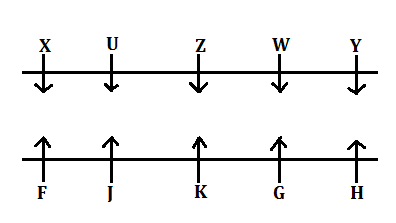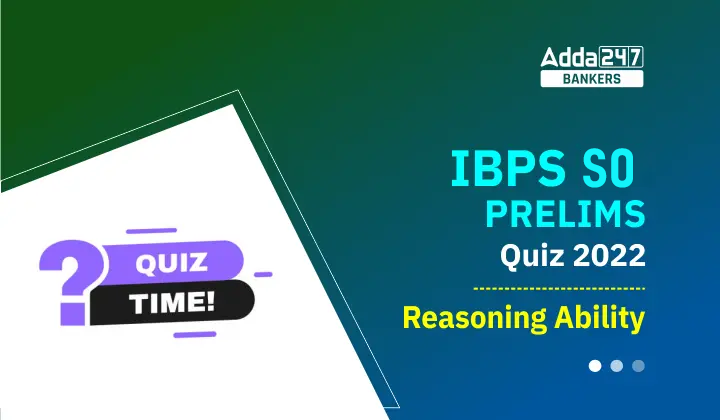Directions (1-5): Study the following information carefully and answer the given questions:
Ten persons are sitting in two parallel rows containing 5 person each in such a way that there is an equal distance between adjacent persons. In row-1 U, W, X, Y and Z are sitting and all of them are facing South. In row-2 F, G, H, J and K are sitting and all of them are facing North. Therefore, each person sits in a row faces another person of other row.
G sits opposite to the one who sits second to the left of the one who sits third to the right of Y. Only one person sits between G and J. X sits second to the right of Z. J faces neither X nor Z. K sits second to the left of H and he does not sit at any of the extreme ends. F is not an immediate neighbour of K. W faces neither K nor J.
Q1. Who among the following sits opposite to U?
(a) J
(b) K
(c) F
(d) H
(e) None of these
Q2. Who among the following sits second to the right of W?
(a) Z
(b) U
(c) Y
(d) X
(e) None of these
Q3. Four of the following five belong to a group in a certain way, find which of the one does not belong to that group?
(a) X
(b) H
(c) Y
(d) F
(e) U
Q4. How many persons sit between K and F?
(a) None
(b) Two
(c) One
(d) Three
(e) None of these
Q5. What is the position of H with respect to J?
(a) Third to the left
(b) Immediate right
(c) Second to the left
(d) Third to the right
(e) Fourth to the right
Directions (6-10): In these questions, a relationship between different elements is shown in the statements. The statements are followed by two conclusions. Given answer
If A@B means A is not greater than B
A#B means A is not greater than or equal to B
A%B means A is not smaller than B
A$B means A is not smaller than or equal to B
A&B means A is not greater than or smaller than B
Q6. Statement: C % D $ E & M # J & L
Conclusion: I. L $ E
II. C % J
(a) if only conclusion I is true.
(b) if only conclusion II is true.
(c) if either conclusion I or II is true.
(d) if neither conclusion I nor II is true.
(e) if both conclusions I and II are true.
Q7. Statement: P & N @ Q $ R $ T & S
Conclusion: I. N % S
II. P @ Q
(a) if only conclusion I is true.
(b) if only conclusion II is true.
(c) if either conclusion I or II is true.
(d) if neither conclusion I nor II is true.
(e) if both conclusions I and II are true.
Q8. Statement: J % P & I % M # T % V
Conclusion: I. M @ J
II. V $ P
(a) if only conclusion I is true.
(b) if only conclusion II is true.
(c) if either conclusion I or II is true.
(d) if neither conclusion I nor II is true.
(e) if both conclusions I and II are true.
Q9. Statement: M @ X @ E $ F & D # O
Conclusion: I. D $ M
II. F @ M
(a) if only conclusion I is true.
(b) if only conclusion II is true.
(c) if either conclusion I or II is true.
(d) if neither conclusion I nor II is true.
(e) if both conclusions I and II are true.
Q10. Statement: E @ F & D # O % K $ G
Conclusion: I. O # E
II. G % F
(a) if only conclusion I is true.
(b) if only conclusion II is true.
(c) if either conclusion I or II is true.
(d) if neither conclusion I nor II is true.
(e) if both conclusions I and II are true.
Directions (11-15): In these questions, relationship between different elements is shown in the statements. The statements are followed by conclusions. Study the conclusions based on the given statements and select the appropriate answer. Give answer-
(a) If only conclusion I is true
(b) If only conclusion II is true
(c) If both conclusions I and II are true.
(d) If either conclusion I or II is true
(e) If neither conclusion I nor II is true.
Q11. Statements: J<O=B>M, A>Q<J, I≤M.
Conclusions: I. A>M
II. O>I
Q12. Statements: S<Z, R≥C≤Z, Q>S, C>K.
Conclusions: I. R>Q
II. K<R
Q13. Statements: Q>M, J=R, J<Q>S≤A
Conclusions: I. R>M
II. R≤M
Q14. Statements: D≥M>N, Z>D≥R, A>C<R
Conclusions: I. N<Z
II. C<D
Q15. Statements: A≥R, J<A, B>T≥R
Conclusions: I. B<R
II. J>R
Solutions
Solution (1-5):
Sol.

S1. Ans. (a)
S2. Ans. (b)
S3. Ans. (e)
S4. Ans. (c)
S5. Ans. (d)
S6. Ans. (a)
Sol. I. L $ E (true)
II. C % J (false)
S7. Ans. (b)
Sol. I. N % S (false)
II. P @ Q (true)
S8. Ans. (a)
Sol. I. M @ J(true)
II. V $ P(false)
S9. Ans. (c)
Sol. I. D $ M (false)
II. F @ M(false)
As D=F
S10. Ans. (d)
Sol. I. O # E(false)
II. G % F(false)
S11. Ans. (b)
Sol. I. A>M (False)
II. O>I (True)
S12. Ans. (b)
Sol. I. R>Q (False)
II. K<R (True)
S13. Ans. (d)
Sol. I. R>M (False)
II. R≤M (False)
S14. Ans. (c)
Sol. I. N<Z (True)
II. C<D (True)
S15. Ans. (e)
Sol. I. B<R (False)
II. J>R (False)





 GA Capsule for SBI Clerk Mains 2025, Dow...
GA Capsule for SBI Clerk Mains 2025, Dow...
 The Hindu Review October 2022: Download ...
The Hindu Review October 2022: Download ...
 IBPS Clerk Mains Cut Off 2025 Out, Check...
IBPS Clerk Mains Cut Off 2025 Out, Check...







